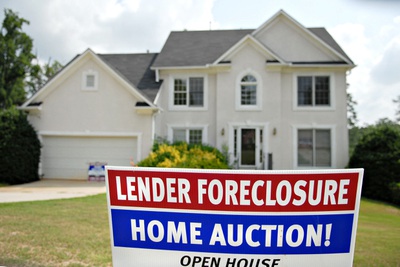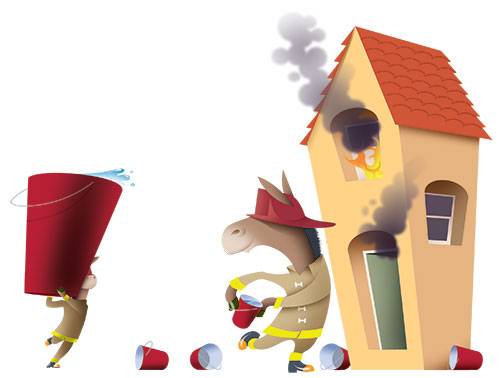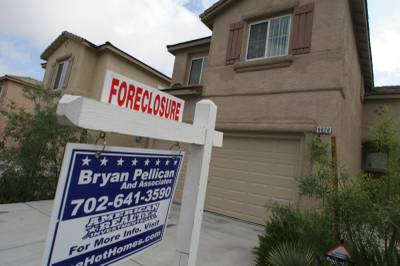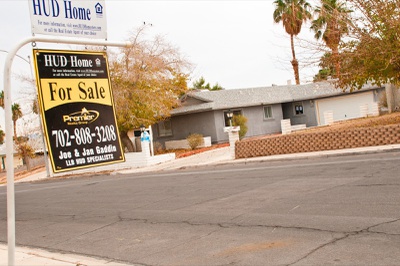Friday, Oct. 5, 2012 | 2 a.m.
Sun coverage
By the winter of 2008, after Barack Obama had been elected president but before he was sworn in, housing experts knew the dire situation Nevada homeowners faced. They also had an inkling of just how cautious the federal response would be.
In December of that year, Senate Majority Leader Harry Reid held a conference call with Nevada real estate experts, housing industry leaders and consumer groups to brief them on a new federal program meant to help underwater homeowners.
After explaining the new federal program, which would encourage banks to allow homeowners to refinance their mortgages at lower interest rates, a number of people on the call spoke up, according to a participant.
The federal program would do little for Nevada, they said. To qualify, homeowners would have to be barely “underwater” — owing only slightly more than their homes were worth. In Nevada, the problem was greater than that.
A HUD housing official told Reid that Nevada homeowners were far too underwater for the program to work in the Silver State.
Reid, on the phone, turned the question to his housing adviser, Mark Wetjen.
“Is that true, Mark?” he said, according to one of the participants.
“Yes, it is,” Wetjen said.
Reid told Wetjen to “get to work.”
At that point, President Barack Obama was months from being sworn into office.
But it was already clear that Las Vegas faced a massive housing crisis that would touch nearly every resident in the state and be a continual drag on its economy.
When he did take office, the Obama administration responded to the crisis with a patchwork of shifting federal programs that have, at least until the past few months, fallen short of stabilizing Nevada’s housing market, according to state economists, housing experts, real estate attorneys and bank representatives.
Early on, the programs seemed designed for markets less severely hit than Nevada, consumer groups said. One program, for example, offered mortgage help for the unemployed but ignored the underemployed — like service industry workers who still technically had a job but had shifts or second jobs cut.
Banks were ill-prepared for the clamor from homeowners seeking to renegotiate their mortgages. They had set up customer service operations adept at collecting mortgage payments during the boom but fumbled dealing with homeowners at risk of foreclosures. Banks would lose or misplace documents. Those applying for a refinance also would be put through the foreclosure process. Homeowners saw months go by while waiting for approval of a short-sale from the banks, only to be told the paperwork they submitted was outdated.
On top of that, federal programs lacked any way to compel lenders to participate in the government programs.
And mortgage giants Fannie Mae and Freddie Mac, which are being overseen by an Obama-appointed director, have rebuffed calls from the administration to allow for “principal reduction”, where the mortgage holders agree to reduce the value of loans.
Obama’s closest advisers acknowledge the federal response hasn’t entirely met the president’s expectations. But, they argue, the programs are far from a failure.
About 16,000 homeowners in the Las Vegas area have received permanent loan modifications through one program, the Home Affordable Modification Program, according to the Department of Housing and Urban Development.
Another program, the Home Affordable Refinance Program, helped another 21,000 Nevada homeowners refinance their mortgages.
“There’s no doubt that we have refined and improved the programs along the way,” said David Axelrod, senior strategist to Obama’s campaign. “And there’s no doubt that the problems were enormous that were created by the collapse of the housing market and difficult, not just for those folks who are facing foreclosure but for whole neighborhoods. Nobody knows that better than people in Nevada.”
Administration officials say that they are aware of the ongoing struggles in the housing market but believe their response has been commensurate with the complexity of the problem — there’s no silver bullet, or single program, that could have turned things around.
The response was “multifaceted and complex to meet the complexity of the housing problem,” said James M. Parrott, senior adviser for the White House’s National Economic Council. “At the end of the day, the market is beginning to heal, but we’re not there yet. There are still too many Americans struggling, too many communities that need help.”
Obama campaign officials also say efforts to expand or change programs have, at times, been blocked by a Republican Congress. And the Obama campaign is quick to point out Republican presidential nominee Mitt Romney’s comments that the housing market should be allowed to “hit bottom.”
But today, the deep wound of the crisis on Nevada’s economy is clear: The state led the nation in per-capita foreclosures for 62 straight months. Today, more than 60 percent of Nevada mortgages are underwater.
That has led some to question whether the Obama administration should have led a more aggressive effort to help homeowners.
“Quite honestly, up until recently, none of the federal programs were very effective,” said Michele Johnson, CEO and president of Consumer Credit Counseling Service of Nevada and Utah, a nonprofit that, at its height in 2009, helped 24,000 people a year.
Johnson said the programs seemed designed for a national market, not severely underwater markets like Nevada.
“They were not effective for Nevadans, given the huge depreciation that we faced,” she said. “The programs were not designed specifically for Nevadans. It was designed for the U.S. It was designed on a national basis.”
Even nationally, however, the statistics paint a picture of an approach that has failed to live up to Obama’s promises.
• In a February 2009 speech in Arizona, Obama announced housing initiatives that he said would help between 7 million and 9 million homeowners avoid foreclosures. But the two major programs, HAMP and HARP, combined with its successor, HARP 2.0, have helped only a combined 2.5 million homeowners nationwide, through July, according to the latest Department of Treasury report. The Federal Housing Administration has additionally offered more than 1.4 million loss mitigation and early delinquency interventions. Federal officials could not provide a state-by-state breakdown of how many homeowners they had expected to help.

A sign advertising foreclosure and auction is posted in the of a home in Decatur, Georgia, on Monday, July 9, 2007. Kazuo Mizuno, chief economist at Mitsubishi UFJ, a unit of Japan's largest bank, said the housing slump will probably throw the U.S. into a recession in the first quarter. Photographer: Chris Rank/ Bloomberg News.
• In February 2010, the federal government announced block grants to states, like Nevada, most devastated by the housing crisis. In Nevada, that meant $194 million in “Hardest Hit Funds” to spend on mortgage relief by 2017, including principal reduction, for homeowners at risk of defaulting. Today, about $20 million — or 10 percent of the money — has been spent or allocated, according to an agency estimate. Of that, about $10 million was spent in the last 90 days.
• And of 4,803 homeowners who sought help through a state foreclosure mediation program, only 49 eventually were enrolled in a federal assistance program.
After three years of less-than-satisfactory results, the Obama administration recalibrated their approach. Among other things, it removed the cap on how underwater homes could be to qualify for refinancing.
The latest program, called HARP 2.0, which took effect in March, has been an improvement, consumer advocates said. And more Nevadans are seeking access to the Nevada Hardest Hit program.
Still, that’s after tens of thousands of Nevadans had lost their homes.
Barbara Buckley, the executive director of the Legal Aid Center of Southern Nevada, said recent expansions of federal programs, particularly HARP 2.0, have been more helpful.
But asked about the federal programs, she said: “Did they help enough people? The answer is no. Was it better than letting people hit bottom, without a lifeboat? Yes.”
Buckley, who until 2009 was the Democratic Assembly speaker, was referring to Republican Mitt Romney’s statement last year in Las Vegas.
"Don't try and stop the foreclosure process. Let it run its course and hit the bottom," he told the Las Vegas Review-Journal editorial board.
Since then, he appeared to backtrack.
“The idea that somehow this is going to cure itself by itself is probably not real,” he said.
Last month, Romney released a seven-page white paper on housing. Five of those pages were a critique of Obama’s “alphabet soup” of housing plans and failure to craft regulations two years after passing legislation.
The plan eschews improving government programs or creating new ones. Instead, the plan is aimed at helping the housing market by selling off 200,000 vacant homes owned by Fannie Mae and Freddie Mac and clarifying regulations to make lending and negotiations between banks and homeowners easier. One regulation supported by Romney, according to an adviser, would allow banks and homeowners to share in any home value increases if banks forgive principal.
The Obama campaign is eager to put their approach up against Romney’s proposal.
“Consider the contrast,” said Axelrod. “There is no doubt the president is earnestly pursuing this. Some things worked and some things haven’t worked as well as we would’ve liked. But on the other side, the candidate is saying let the housing market bottom out and not to intervene. If that had happened, hundreds of thousands of homeowners across this state would be much less well off even than they are today. But we recognize that it is a continuing challenge for us.”
It’s hard to imagine a government program that could cure Las Vegas’ housing woes. And even the most fervent consumer advocates admit that some homes in the burst bubble had to inevitably lead to foreclosures.
Between 2002 and 2006, Las Vegas was enveloped in a collective gold-rush mentality, fed by easy bank loans and homeowners-turned-investors with dreams of getting rich by flipping homes. The problem, post crash, was immense.
“A generation of wealth was lost,” said Jeremy Aguero, principal of financial firm Applied Analysis in Las Vegas.
Even Obama, in the speech in Arizona in February, said his programs were never targeted to help everyone.
“I want to be very clear about what this plan will not do: It will not rescue the unscrupulous or irresponsible by throwing good taxpayer money after bad loans,” he told the audience. “It will not help speculators — it will not help speculators who took risky bets on a rising market and bought homes not to live in but to sell. ... It will not reward folks who bought homes they knew from the beginning they would never be able to afford. So I just want to make this clear: This plan will not save every home.”
But Obama, in later statements, has acknowledged that the housing crisis has proved a stubborn problem.
“This is probably the biggest drag on the economy right now,” he said at a town hall meeting in April 2011.
Obama campaign advisers said the administration’s response has helped thousands of Nevadans while also acknowledging that programs have to be changed. They’d like to be more aggressive now but blame a Republican Congress for stymying efforts to adjust some of those programs.
Housing and Urban Development Director Shaun Donovan, at a Las Vegas Sun editorial board meeting last week, noted the sharp rise in Nevadans taking advantage of housing programs in recent months.
“I think it’s hard to look at what we’ve done and say there wasn’t aggressive action,” he said. “When history is written from some distance, I think the view will be there was very aggressive action taken.”
One aspect of the crisis that he admitted the government was unprepared for was the inability of the banks who owned or serviced the loans to implement the programs.
“We did not realize the depth of problems of servicers,” he said. “One reason, the programs did not have as big an impact as originally expected, servicers did not have capacity to implement them.
“It was not a failure of aggressiveness. It was a failure of a mechanism to implement them.”
That’s a problem Buckley agreed with.
“From the very beginning of the crisis, the banks were, at best, unprepared. At worst, they were callously indifferent to the needs of the homeowners,” she said. “What’s been missing from the very beginning is a strong enforcement piece.”
Buckley said programs should have had a component that allowed homeowners to reduce their principal, an underlying cause of the continually distressed housing market in Nevada.
But federal officials said there was only so much they could do to compel the banks without legislation.
A senior administration official said that under the Troubled Asset Relief Program, the government could only offer incentives for the banks who serviced mortgages to participate in the programs.
Enter a legal settlement reached in February between the country’s five largest banks, the federal government and 49 state attorneys general, including Nevada.
Banks promised to offer $25 billion in relief to homeowners through principal reductions, short sales and forgiving second loans. In exchange, the federal government and states agreed to drop investigations into widespread fraud believed to be used in foreclosure processes, such as automated “robo-signings.”
The settlement provides benchmarks that those banks are required to meet.
“The settlement has changed our leverage,” the administration official said. “Now the major lenders are obligated to build out systems to provide more aggressive relief, with consequences if they fail."
By some measures, the housing market is beginning to turn around. And participation in government programs that help homeowners modify or refinance mortgages has, in recent months, increased dramatically.
Bill Uffelman, head of the Nevada Bankers Association, said that the rules of the programs were changing too quickly, making it difficult for banks to deal with the deluge of modification requests. But he also acknowledged that banks were, like other institutions, unprepared to deal with the flood of calls for help.
“Some of the programs have been more effective than others, in part because they came later in the cycle,” he said. "This has been a learning process for everyone.”
The federal administration official said that forcing banks to set up internal structures to deal with homeowners will be a lasting legacy of the government programs.
“These programs have ended up establishing a template that the entire industry has had to get behind, changing fundamentally how many of these lenders help struggling homeowners,” the official said.
At the start of the crisis, the emphasis of the response was to save the banking industry from collapse — the reverberations from which could have thrown the world into a depression, economists argue.
The bank bailout, the Troubled Asset Relief Program, originally passed in 2008 (with the support of Obama, then-Republican presidential nominee John McCain and Romney) and authorized up to $700 billion in relief for the banks.
But propping up the banks did nothing for most homeowners.
A number of economists now say that it was the wrong response to the financial crisis.
One of those is Dr. Stephen Brown, a professor of economics and director of the Center for Business and Economic Research at UNLV.
“We didn’t want banks to collapse,” he said. “That was what we learned in the Great Depression. It made the economy much more difficult to grow.”
But, he said: “What we didn’t learn from the Great Depression, now we’ve learned from the Great Recession, is if you don’t fix consumer balance sheets, it makes it much more difficult for the economy to grow.”
Underwater homeowners look at their finances and decide to cut back. That reduces spending, which further prevents the economy from recovering.
“I don’t see why we bailed out the financial institution in a way that leaves the underlying problem in place,” Brown said. “We’re still dealing with the underlying problem.”
He said reducing the mortgages of homeowners instead of the banks shouldn’t have cost any more money than the original TARP.
Administration officials believe that with the changes to the government programs in place and the foreclosure settlement agreement, which took effect in April, things will get easier for homeowners and the housing market.
But Obama, in his weekly address last week, once again acknowledged that the slow housing recovery was a drag on the economy and signaled he’s not content to rest with the revamped federal programs now on the books.
He pointed to legislation still pending before Congress that would further simplify refinancing, giving “every responsible homeowner the chance to save about $3,000 a year on their mortgages by refinancing at lower rates.”
But Congress didn’t take up the bill before recessing to campaign.
“The truth is, it’s going to take a while for our housing market to fully recover,” Obama said. “But it’s going to take a lot more time — and cause a lot more hurt — if Congress keeps standing in the way.”




Join the Discussion:
Check this out for a full explanation of our conversion to the LiveFyre commenting system and instructions on how to sign up for an account.
Full comments policy